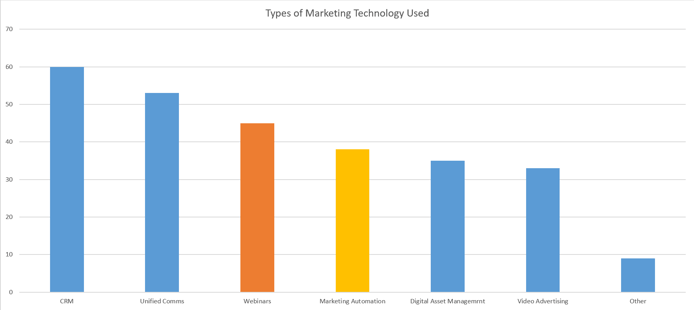How are you leveraging your website to convert anonymous traffic into qualified leads?
Webinars have been a long standing technique for the delivery of highly qualified leads with over 65% of B2B marketers using them.
In fact, webinars are one of the top 3 content techniques for generating leads alongside email and paid search.
The Rise of Marketing Automation
Marketing automation is now helping drive the efficiency, productiveness and volume of our digital marketing activities. With the MA market growing at an exponential rate and valued at over $1.5Bn in 2015 and over 76% of the 17 largest SaaS companies in the world using marketing automation, it’s clear that these tools are becoming increasingly essential to today’s marketers.

Marketing automation technology is becoming hugely effective at coupling some of the core functionality of email, CMS and CRM platforms with rules based workflows to drive engagement and leads.
However, up to now webinars have been left out of this functionality stack.
There is good reason for this as webinar technology is complex to build and maintain and is often proprietary in its nature e.g Webex and Citirix.
Therefore, these tools are often used independently. This increases the level of effort to run webinar campaigns and makes it harder to gauge ROI.
However, this doesn’t now have to be the case and many marketers are now using their marketing automation platform in combination with their webinar software to achieve demand generation, customization and resource efficiencies.
Marketing Automation Integration
Taking data from webinar tools and placing it into the Marketing Automation platform requires a data integration or for data to be manually exported, manipulated and then imported into the MA platform which can be difficult and in some cases very time consuming.
Basic Data Integration
Many webinar vendors are investing in building ‘standard’ connectors/integrations to pass data between the 2 platforms with the webinar tool connector passing registration and attendance data to the MA platform. This then allows lead scoring and marketing automation workflows to include this basic webinar data.
There are however challenges with this approach.
Web Conferencing vendors such as Webex and Citrix want to build and maintain only a simple connector to many platforms and whilst this may suffice if you only do a few webinars it starts to break down for a number of reasons such as:
- More advanced data is required by marketers such as viewing times, poll data, questions and download data that isn’t supported by the connector.
- Advanced mapping is difficult as Marketing Users want to map advanced webinar data to custom fields
- The synchronization time is not appropriate – many standard connectors only synchronize daily which doesn’t really support on demand viewings or fast turnaround of lead data
- Connectors using API’s are difficult to keep up to date and MA vendors find it increasingly difficult to support 3rd party add ons
- Users of marketing automation platforms increasingly want to use their MA platforms for webinar registration forms and email communications.
Advanced Data Mapping
Some webinar vendors will offer a more advanced data mapping that allows Marketing managers to map more advanced data to custom fields in their MA platforms.
This has a number of advantages for regular webinar users as it provides a much richer view of what the webinar attendee’s behaviour was. The advanced data mapping can be done in a number ways depending upon the vendor and the platform being integrated with but can support:
- Registration data
- Live Attendee data
- Live attendee viewing time data
- On Demand/Channel attendee and viewing time data
- Attendee activity data e.g Poll, Q&A, Chat, Downloads, Clicks
Embedded Webinars – The Future
With the advent of html and cloud based webinar technology you can now use embed code to run your event from within other web pages. You can host all of your webinar and webinar channels simultaneously on multiple websites and landing pages.
So, why is this great for marketers and for the relationship with Marketing Automation platforms? Here are a few reasons:
- Marketers are able to leverage the power of their Marketing automation platforms to drive webinar campaigns without the need for 3rd part connectors.
- Registration and other communications can be driven from Marketing Automation platforms just as for other content.
- Embedding webinars supports all upcoming, live and recorded content and is fully mobile responsive, optimizing the experience to the screen size no matter the device your audience is viewing from.
- Webinars no longer have to look like an extension to your website or a 3rd party solution, they are now in your website so your content, branding, messaging and solutions to your top prospects is completely consistent.
- The requirement for attendees to have plugins or flash installed is removed meaning more registrations and more attendees.
This shift in technology is likely to move webinars even higher up the scale with regard to engagement.
You’ll be able to generate more leads while providing a completely branded experience to your prospects, whilst using common tools to build landing pages, registration and communcations.
In addition to the functional upgrades for marketers, the improved user experience for attendees encourages greater interactions during live and on demand events and re-engagement across the live and on-demand content in your channel. Attendees can further engage with your content (and boost their lead scores) by asking questions, participating in polls, and downloading attachments right from the event in your website.
Webinars can now be viewed in the same ecosystem as video but with element of live presenting and interaction.
Share this
You May Also Like
These Related Stories

6 Lead-Gen Ideas To Increase Webinar Conversion Rates

How to Use Webinars in Your University Marketing Strategy


